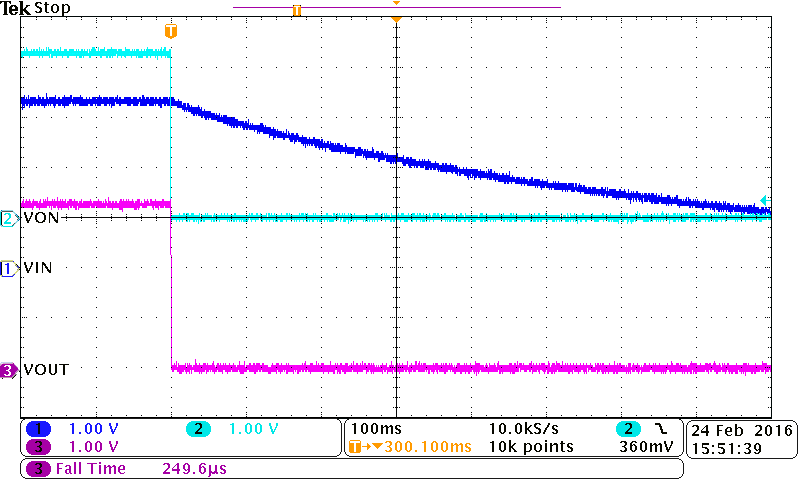SLVSCZ8B July 2016 – December 2019 TPS22918-Q1
PRODUCTION DATA.
- 1 Features
- 2 Applications
- 3 Description
- 4 Revision History
- 5 Pin Configuration and Functions
- 6 Specifications
- 7 Parameter Measurement Information
- 8 Detailed Description
- 9 Application and Implementation
- 10Power Supply Recommendations
- 11Layout
- 12Device and Documentation Support
- 13Mechanical, Packaging, and Orderable Information
Package Options
Mechanical Data (Package|Pins)
- DBV|6
Thermal pad, mechanical data (Package|Pins)
Orderable Information
9.2.2.3 Shutdown Sequencing During Unexpected System Power Loss
Microcontrollers and processors often have a specific shutdown sequence in which power must be removed. Using the adjustable Quick Output Discharge function of the TPS22918-Q1, adding a load switch to each power rail can be used to manage the power down sequencing in the event of an unexpected system power loss (battery removal). To determine the QOD values for each load switch, first confirm the power down order of the device this is wished to power sequence. Be sure to check if there are voltage or timing margins that must be maintained during power down. Next, refer to Table 1 in the Quick Output Discharge (QOD) section to determine appropriate COUT and RQOD values for each power rail's load switch so that the load switches' fall times correspond to the order in which they need to be powered down. In the above example, make sure this power rail's fall time to be 4 ms. Using Equation 2, to determine the appropriate RQOD to achieve our desired fall time.
Because fall times are measured from 90% of VOUT to 10% of VOUT, Equation 2 becomes Equation 4.
Refer to Figure 7, RPD at VIN = 5 V is approximately 25 Ω. Using Equation 1, the required external QOD resistance can be calculated as shown in Equation 6.
Figure 24 through Figure 29 are scope shots demonstrating an example of the QOD functionality when power is removed from the device (both ON and VIN are disconnected simultaneously). The input voltage is decaying in all scope shots below.
- Initial VIN = 3.3 V
- QOD = Open, 500 Ω, or shorted to VOUT
- CL = 1 μF, 10 μF
- VOUT is left floating
NOTE: VIN may appear constant in some figures. This is because the time scale of the scope shot is too small to show the decay of CIN.

| VIN = 3.3 V | CIN = 1 µF | CL = 1 µF |
| QOD = Open |

| VIN = 3.3 V | CIN = 1 µF | CL = 1 µF |
| QOD = VOUT |

| VIN = 3.3 V | CIN = 1 µF | CL = 10 µF |
| QOD = 500 Ω |

| VIN = 3.3 V | CIN = 1 µF | CL = 1 µF |
| QOD = 500 Ω |

| VIN = 3.3 V | CIN = 1 µF | CL = 10 µF |
| QOD = Open |

| VIN = 3.3 V | CIN = 1 µF | CL = 10 µF |
| QOD = VOUT |